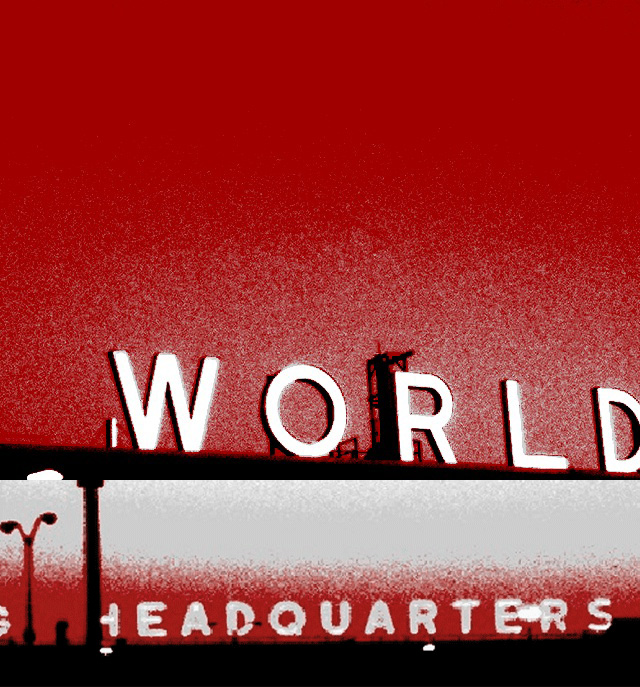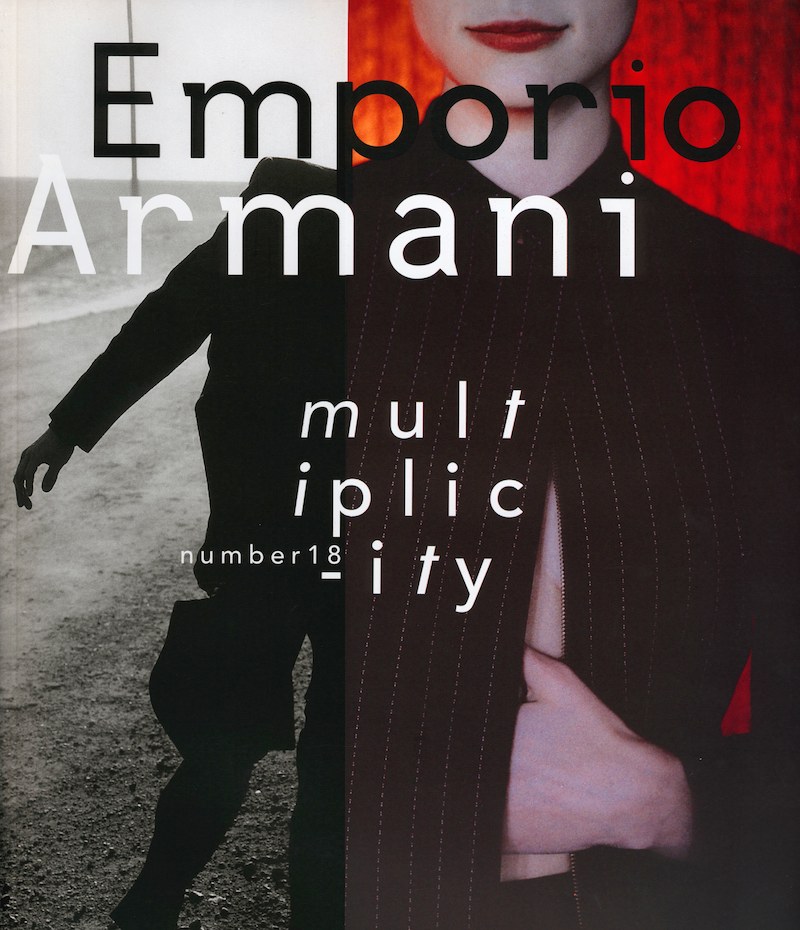archive: review-problem solvers: Problem solvers, priests and pests
Impressions from David Carson, famed designer of letters tattered, toppled and tumbled
BY HANS KLEEFELD
“Don’t mistake legibility for communication” “You can’t not communicate.” If you’re familiar with these observations, you’ll know of David Carson, and you’ll know his work-for the magazines Ray Gun, Surfer and Beach Culture; for Armani and Quiksilver fashions; for Fox television. In Canada, Carson had a hand in the Bank of Montreal’s Fingerprint and the Leap Batteries campaigns.
If you’ve never encountered the man, pity. He’s got a laid-back sense of humour about what he does, and the graphic design profession generally, which goes a long way to defuse irritation that conservative type practitioners may feel towards Carson’s sometimes grating graphics. Anyway, he recently had and audience at the Design Exchange in Toronto laughing through most of his presentation.
Some of the hilarity was triggered by slides of graffiti and inadvertently humorous random graphics that Carson apparently tracks down and records in search of inspiration. This, he suggests, is what designers should observe, rather than our over each other’s work in design magazines and annuals.
Particularly intriguing were several shots of torn posters revealing odd details of imagery from previous postings beneath. Accidental though such effects are, they nevertheless encourage viewers to find some meaning in them. David Carson is not the only one who seems thus “life-focused,” but maybe he is exploiting it more astutely than others.
If one were to put graphic designers into categories, there might be three: problem solvers, priests and pests.
Problem solvers make up the majority. Whether conservative or cool in their work, they quietly do their stuff for countless corporations’ causes. They’re the unsung heroes behind messages competently fashioned in a spirit once defined by Herb Lubalin, well-known NewYork type-whizin his day, as: The best typography never gets noticed.
Priests, then, are a select few individuals who a combination of circumstances has elevated to professional luminosity. Priests generally become what they are through irreverent work which many problem solvers wished they’d done, but didn’t have the nerve to generate and sell; and of course, through unabashed self-promotion. David Carson, like Britain’s Neville Brody and Canada’s Bruce Mau, is a member of that group, which seems to unfailingly inspire some while aggravating others.
Pests, finally, are hordes of desktop meddlers whose software prowess is surpassed only by their soft grasp of type and design basics-common sense rules that problem solvers follow conscientiously, and that priests like to break with cheerful vigor. Pests make up a murky mass, best ignored-if it weren’t for the dread prospect that pests may unwittingly take us one step closer to virtual design and Mclayouts.
Why do designers choose to not only bend, but break traditions? Are they shooting themselves in the foot? Or are they doing both for their clients and their clients’ audiences a valuable service?
Consider here Carson’s first-quoted statement: don’t mistake legibility for communication. Most problem solvers’ communication efforts are decidedly driven by legibility objectives-make brand names and product benefits clearer, bigger, bolder. Show and tell everything. That’s fine in theory and by itself. But what if all competitors, and a zillion other sellers do the same? Any chance that viewers may get bored out of their skulls by endless overkill? look around and you may notice a nation of scanners, who flip-flip-flip through pages or channels. For those living in a hurry, is legibility really a hot commodity?
Communication implies engagement. Marketing gurus endlessly acclaim emotional involvement as the road to consumers’ minds, hearts and wallets. What if it’s no longer possible to seriously engage with overplayed, tried-and-trusted formats? David Carson seems to suggest that you now have to be very different to be noticed and to penetrate viewers’ consciousness. That observation, at least, clearly has merit.
Carson’s second-quoted statement-you can’t not communicate-is equally provocative. At first glance, it seems to merely state the obvious. But what if it refers to what you don’t show or tell? What if absence of daring visuals signals lack of spirit; what if the obvious, no matter how well-designed in its own right, sends a message of conformity?
What wants to be read at length obviously should at least be fairly legible. Even Carson’s own Web site bio (at www.davidcarsondesign.com) is straight lower case sans serif type without font mixes (though the lines are pretty long and packed close); but then the bulk of graphic deisgn communication, both in print or video, operates more and more in sight-and soundbite fashion, anyway. Here David Carson’s ground-breaking kaleidoscopic, visually pulsating imagery presents, if not a standard, then at least a reference that may well inspire others to search for new ways to put messages across.
HANS KLEEFELD is a creative director at Watt International in Toronto.







archive: review-intuition: intuition , text: Gertrud Sandqvist
From The Book 2nd Sight-The Grafik Design of David Carson :
It has been repeated ad nauseam that post-industrial culture is predominantly visual. If that is the case, do the visual arts need to be separated off into some special category?
Yes. Contrary to the accepted view, the position of the visual arts in Western society has remained amazingly undisturbed. The fact that we are still able to appreciate a Renaissance painting shows how little the conditions for the visual arts have changed with society as a whole.
All these new media that allow the production of a continuous stream of images make it easier to distinguish the properties that give art its special status.
Jean Martin Charcot thought the delusions of his hysterical patients were caused by their allowing a stream of images to create a barrier between themselves and reality. They dreamed. They resisted a reality that they experienced as too threatening by replacing it with illusions or hallucinations; phantoms to which their bodies or minds could react. Charcot and his successors noticed that by talking to an afflict-ed individual, and by getting her to speak, they could help her to live without these images. According to them, and to Western philosophy from Descartes onwards, language organizes the self. This is the root of the widely held belief in the precedence of the word over the image .
When the Surrealists wanted to access to the unconscious springs of visual creativity, one object of their admiration was the hysteric, the lunatic, and her images. They worshipped kitsch, found objects, and all forms of photography; any visual sources that got away from the possibility of choice, and thereby from the ascription of value. In practice, this meant rejecting all visual art that could be considered important in the sense of making demands on the viewer.
Surrealism was long seen as a peripheral movement, and mostly interesting as a phenomenon that reflected its time. It has been remarked that the Surrealists’ defense of hysteria can be viewed as a reaction to an unendurable reality, to an insane period between two world wars. The hysteric is not free. She repeats images compulsively, as a defence. The Surrealists also lived through the break-through of mass visual culture. They lived in societies whose leaders understood the potential for manipulation offered by having pictures produced that shattered the self and its capacity for inde-pendent judgement; and they used this to make whole peoples hysterical. Interestingly enough, these leaders also loathed difficult visual art, perhaps primarily because it was useless for their purposes.
Interesting enough, these leaders also loathed difficult visual art, perhaps primarily because it was useless for their
But many of the Surrealists were important artists. This was because their practice looked different from their practice looked diffrent from their theo-ry. Their combination of hysteria with the mass-production of an appar-ently undifferentiated stream of images actually entails a profound understanding of what distinguishes visual art from other types of image, and from the images produced by the psyche. The Surrealists celebrated terror, meaninglessness, the dissolution of all cohesion, the disintegra-tion of the self. But they did so in pictures whose factual existence con-tradicts their own theses. And then they, too, were persecuted.
Might we not stay that visual art involves a resistance to, not an imitation of, the images produced by the psyche? And that this is why it can have a healing effect? That visual art is dependent on choices made from within the part of our experience that is inaccessible to language, and which thus represents an alternative way of building the bridge between self and would that is also a function of the world?
This has far-reaching consequences. For one thing, it means that only part of a work of art is open to analysis, while, on the other hand, the work can, of course, be described and can constiture starting point for an interpretation. Nonetheless, the work exists as both its own reality and as a more or less complex model for an assumption about reality.
Confusion of the human psyche’s inherent capacity to produce images with the capacity to make visual art can give rise to the misconception that everyone has a need for, or at least potentially has the capacity to make, visual art. It follows from this that there need be no connection between a visual culture that, for the sake of influence, imitates the way the psyche produces images, and visual art. Nor does there have to be any connection between a culture that depicts real-ity mechanically and visual art.
By resisting psy-chic images (which are sometimes called illusions) visual art can give as an understanding of the connections between the self and the world, one that is accurate in a different way from the accuracy of language. This implies that the various tools that have been constructed for thinking, such as philosophy or, more specifically, logic, are of no use here other than as parallels.
Another thing that distinguishes visual art from other art forms is that it demands a link between secing and doing, between perception and the hand as a part of the body, and the body as located in the actual, existing space. Now that perception, seeing, has been associated to such a degree with theories about the way consciousness and language function, visual art has once again been linked, by the back way, with language and its way of achieving insight. But let us go in the other direction: hand-seeing-conscious-ness.
It is characteristic of all kinds of handicraft that we learn to master them through someone showing us what to do and then imi-tating them. This applies to all skills that are not medi-ated through language, from riding a bicycle to cooking. Then, as we gradually gain in skill, we learn a set of rules that is applicable to that specific handicraft. This set of rules is a concentrate of experiences accumulated, the individual is able to gain the freedom to deviate from it in a particular direction.
Accumulated experience that is not immediately accessible to lan-guage, but which does affect our consciousness, is usu-ally called intuition. An intuitive choice is thus as con-scious as a considered choice, it simply uses aspects of consciousness that are not accessible to language. It cannot say, but it can show.
Whenever any form of knowledge that has been acquired through means other than language is to be assessed or applied to something eles, this is done, I think, by making intuitive choices. Another term for it could be “silent knowledge”, believe these intuitive choices are crucial to what the artist sees, and thus to the question/problem/possibility that he or she wants to adress in the artwork. It then becomes inappropriate to ask a variety of questions, because they cannot be explored in a relevant way with-in the context of the work. Without the hand’s familiar-ity with the material that has always played a crucial role in people’s ability to replace dream images with factual skills, these choices cannot be made.
It is here that visual art’s resistance to the dream image comes into play, in a mode of seeing that is founded on relevant choices arrived at through intuition. As choices are followed through, various distinctions are established, what we occasionally call aesthetics, and which consist of qualitative comparisons. Naturally enough, these distinctions are also primarily interpreted through experience, but not necessarily only experience that is acquired through the familiarity of the hand. We are in the domain of seeing, and more generally of the body’s ability to apprehend proportions, spatial relations, nuances, via the sences.
This seeing also structures consciousness, and, in that it exists side by side with language, the experience can be referred to linguistically, but it cannot be mediated through language.
And the artist contemplates her work; what it might mean, in which context it belongs, how it is to be executed, with what it can be compared. Artist and viewer, in a shared produc-tion of meaning.
Through her capacity to apply knowledge from the entire sphere of human experience, the artist is able to make real images, which by profoundly changing our conception of reality confirm the primary hallmark of reality, its changeability.
This generates a humility in the face of the image’s resistance. Since visual art is a form of reality, it is unpredictable. In contrast to the image that is made in order to imitate our illusions, visual art cannot be produced by mere speculation.
Is that why in many cultures visual art has been linked with magic?
Not because it deals with illusions, but because it is not open to external control? And because it is founded on non-linguistically mediated knowledge? Wizards and witches became powerful because they mediated the experience of the connection between factual and perceived reality that was, and is, vital.
And, there, we come back to intuition. When a visual artist claims that he or she does not think, this rarely implies some form of somenambu-lant state. It means that she uses experiences that are not accessible to language other than through a reconstraction of a course of events. Understood in this way, intuition becomes a composite term for an active, demanding way of experiencing and reworking reality.
Such a visual art does not permit the viewer to be lulled into inactivity by her own, familiar dreams.
It demands that the whole person be awake, so that she knows what she is seeing,
rather than that she sees what she knows.
From The Book 2nd Sight-The Grafik Design of David Carson :
It has been repeated ad nauseam that post-industrial culture is predominantly visual. If that is the case, do the visual arts need to be separated off into some special category?
Yes. Contrary to the accepted view, the position of the visual arts in Western society has remained amazingly undisturbed. The fact that we are still able to appreciate a Renaissance painting shows how little the conditions for the visual arts have changed with society as a whole.
All these new media that allow the production of a continuous stream of images make it easier to distinguish the properties that give art its special status.
Jean Martin Charcot thought the delusions of his hysterical patients were caused by their allowing a stream of images to create a barrier between themselves and reality. They dreamed. They resisted a reality that they experienced as too threatening by replacing it with illusions or hallucinations; phantoms to which their bodies or minds could react. Charcot and his successors noticed that by talking to an afflict-ed individual, and by getting her to speak, they could help her to live without these images. According to them, and to Western philosophy from Descartes onwards, language organizes the self. This is the root of the widely held belief in the precedence of the word over the image .
When the Surrealists wanted to access to the unconscious springs of visual creativity, one object of their admiration was the hysteric, the lunatic, and her images. They worshipped kitsch, found objects, and all forms of photography; any visual sources that got away from the possibility of choice, and thereby from the ascription of value. In practice, this meant rejecting all visual art that could be considered important in the sense of making demands on the viewer.
Surrealism was long seen as a peripheral movement, and mostly interesting as a phenomenon that reflected its time. It has been remarked that the Surrealists’ defense of hysteria can be viewed as a reaction to an unendurable reality, to an insane period between two world wars. The hysteric is not free. She repeats images compulsively, as a defence. The Surrealists also lived through the break-through of mass visual culture. They lived in societies whose leaders understood the potential for manipulation offered by having pictures produced that shattered the self and its capacity for inde-pendent judgement; and they used this to make whole peoples hysterical. Interestingly enough, these leaders also loathed difficult visual art, perhaps primarily because it was useless for their purposes.
Interesting enough, these leaders also loathed difficult visual art, perhaps primarily because it was useless for their
But many of the Surrealists were important artists. This was because their practice looked different from their practice looked diffrent from their theo-ry. Their combination of hysteria with the mass-production of an appar-ently undifferentiated stream of images actually entails a profound understanding of what distinguishes visual art from other types of image, and from the images produced by the psyche. The Surrealists celebrated terror, meaninglessness, the dissolution of all cohesion, the disintegra-tion of the self. But they did so in pictures whose factual existence con-tradicts their own theses. And then they, too, were persecuted.
Might we not stay that visual art involves a resistance to, not an imitation of, the images produced by the psyche? And that this is why it can have a healing effect? That visual art is dependent on choices made from within the part of our experience that is inaccessible to language, and which thus represents an alternative way of building the bridge between self and would that is also a function of the world?
This has far-reaching consequences. For one thing, it means that only part of a work of art is open to analysis, while, on the other hand, the work can, of course, be described and can constiture starting point for an interpretation. Nonetheless, the work exists as both its own reality and as a more or less complex model for an assumption about reality.
Confusion of the human psyche’s inherent capacity to produce images with the capacity to make visual art can give rise to the misconception that everyone has a need for, or at least potentially has the capacity to make, visual art. It follows from this that there need be no connection between a visual culture that, for the sake of influence, imitates the way the psyche produces images, and visual art. Nor does there have to be any connection between a culture that depicts real-ity mechanically and visual art.
By resisting psy-chic images (which are sometimes called illusions) visual art can give as an understanding of the connections between the self and the world, one that is accurate in a different way from the accuracy of language. This implies that the various tools that have been constructed for thinking, such as philosophy or, more specifically, logic, are of no use here other than as parallels.
Another thing that distinguishes visual art from other art forms is that it demands a link between secing and doing, between perception and the hand as a part of the body, and the body as located in the actual, existing space. Now that perception, seeing, has been associated to such a degree with theories about the way consciousness and language function, visual art has once again been linked, by the back way, with language and its way of achieving insight. But let us go in the other direction: hand-seeing-conscious-ness.
It is characteristic of all kinds of handicraft that we learn to master them through someone showing us what to do and then imi-tating them. This applies to all skills that are not medi-ated through language, from riding a bicycle to cooking. Then, as we gradually gain in skill, we learn a set of rules that is applicable to that specific handicraft. This set of rules is a concentrate of experiences accumulated, the individual is able to gain the freedom to deviate from it in a particular direction.
Accumulated experience that is not immediately accessible to lan-guage, but which does affect our consciousness, is usu-ally called intuition. An intuitive choice is thus as con-scious as a considered choice, it simply uses aspects of consciousness that are not accessible to language. It cannot say, but it can show.
Whenever any form of knowledge that has been acquired through means other than language is to be assessed or applied to something eles, this is done, I think, by making intuitive choices. Another term for it could be “silent knowledge”, believe these intuitive choices are crucial to what the artist sees, and thus to the question/problem/possibility that he or she wants to adress in the artwork. It then becomes inappropriate to ask a variety of questions, because they cannot be explored in a relevant way with-in the context of the work. Without the hand’s familiar-ity with the material that has always played a crucial role in people’s ability to replace dream images with factual skills, these choices cannot be made.
It is here that visual art’s resistance to the dream image comes into play, in a mode of seeing that is founded on relevant choices arrived at through intuition. As choices are followed through, various distinctions are established, what we occasionally call aesthetics, and which consist of qualitative comparisons. Naturally enough, these distinctions are also primarily interpreted through experience, but not necessarily only experience that is acquired through the familiarity of the hand. We are in the domain of seeing, and more generally of the body’s ability to apprehend proportions, spatial relations, nuances, via the sences.
This seeing also structures consciousness, and, in that it exists side by side with language, the experience can be referred to linguistically, but it cannot be mediated through language.
And the artist contemplates her work; what it might mean, in which context it belongs, how it is to be executed, with what it can be compared. Artist and viewer, in a shared produc-tion of meaning.
Through her capacity to apply knowledge from the entire sphere of human experience, the artist is able to make real images, which by profoundly changing our conception of reality confirm the primary hallmark of reality, its changeability.
This generates a humility in the face of the image’s resistance. Since visual art is a form of reality, it is unpredictable. In contrast to the image that is made in order to imitate our illusions, visual art cannot be produced by mere speculation.
Is that why in many cultures visual art has been linked with magic?
Not because it deals with illusions, but because it is not open to external control? And because it is founded on non-linguistically mediated knowledge? Wizards and witches became powerful because they mediated the experience of the connection between factual and perceived reality that was, and is, vital.
And, there, we come back to intuition. When a visual artist claims that he or she does not think, this rarely implies some form of somenambu-lant state. It means that she uses experiences that are not accessible to language other than through a reconstraction of a course of events. Understood in this way, intuition becomes a composite term for an active, demanding way of experiencing and reworking reality.
Such a visual art does not permit the viewer to be lulled into inactivity by her own, familiar dreams.
It demands that the whole person be awake, so that she knows what she is seeing,
rather than that she sees what she knows.

ad in print magazine for the aspen design conference. theame was “hollywood” Since 1981 Carson has attended the International Design Conference in Aspen. In 1995 he joined the board of directors. In 1996 he made an effort to bring together various different camps in American graphics, personally inviting designers Ed Fella, Martin Venezky, Jeff Keedy and Rudy Vanderlans (the only one to decline)
archive: review-968: ross resnick, from australia, talks about logos
The Main Idea
Logos began when psychopathic thugs in the distant past became successful enough to have personal logos which were then called Heraldry. Heraldry caused considerable excitement and quickly lead to Pageantry. Pageantry was based on the ability to run popular events and have your logo held aloft on big sticks. Over the years,with the help of Heraldry and Pageantry the descendants of the most successful of the psychopaths became known as Royalty. This lead to the establishment of corporate headquarters called Palaces and if the palaces were using T QM then the meals were served on time and the horses were groomed properly. As time went by the palaces became larger and the chins became smaller. The whole scam became known as corporate identity and is still popular.
Corporate progress assisted the poor who in return for obedience were granted illiteracy and in return were allowed their own logos . If the local publican painted the word BEER on his sign it wouldn’t mean much to you because you’d be illiterate. For all you known the sign might say Enrol here for a life in the army or Gravedigger wanted to bury Black Plague victims. It just wasn’t worth the risk.
But if the publican paints a big foaming jug of beer on his sign there’s not a double entendre in sight. He’s got you. He’s got me anyway. So welcome to the poor person’s first logo where you can happily drink your beer beer, bang on the bar and shout…Bloody awful logo ,worse than Westpac. The designer knight at the end of the bar, dressed in black can shout…Nothing could be worse than Westpac .
Design has a long history ,many faces and some problems .One of the first problems is that most graphic designers aren’t writers. Or even readers, poor things. Designers see writers from a different and difficult direction. If the designer befuddles the writer’s idea the whole project becomes a turgid puddle.
Some designers understand the double writer/designer function and they’re usually the ones who keep getting good work for their entire lifetime even if they aren’t very good designers. l know a few of these people and they’re very happy especially if they have a hobby to feed their creative urges. As they sit on their Versace ploughs and watch their grapes ripen they thank the Lord that they kept firing clear and cogent messages into people’s brains.
Telecoms have the same function.. They get paid to fire a message with as little static as possible from the head of one person on the planet into the head of another through the ear. In their business if the static is high the profit is low. This decade static is fashionable..People as talented as David Carson can pull off visual static with style and big invoices. People who copy him usually can’t. Carson has the ability to find the main idea and ignore the secondary idea which sometimes disguises itself as the main idea. He then deconstructs and reconstructs the main idea.
A reasonable example of lack of recognition of the main idea occurred in an industrial design context on a sunny day at Isandhlwana in South Africa in 1887 when a thousand English troops ran into an impi of more than 20,000 Zulus intent on killing them.No sweat. The English had rifles,the Zulus had spears. The English formed into the system of rifle squares in rows of three so that two soldiers were reloading while one was firing. They were single shot rifles and slow to load but the system filled the air spaces with walls of lead
The Zulus were as usual but soon there were hip high piles of their bodies still some distance from the English. As the rifles cracked and killed,back in Manchester the designer of the new English ammunition box was probably feeling pleased with himself as he spent his fee. Back in Isandhlwana the Zulus were getting closer as the firing slowed. The quartermaster sergeants in the middle of the square were frantically trying to open the new ammunition boxes.
Back in Manchester the ammunition box designer was probably having morning tea and thinking how clever he was in sealing the ammunition boxes with two copper bands and twenty seven philips head screws. Those black buggers won’t be able to pilfer the ammunition now he thought
Back in Isandhlwana every English soldier was dead. In a battle they couldn’t lose because of the technology the rifle the English had lost because of dumb and dangerous thinking by the designer of the ammunition box who concentrated on the secondary idea. The design philosophy was pretty good for stopping pilfering but not very good at getting handfuls of bullets. The day after Isandhlwana and a few kilometres away ,Michael Caine, by opening the boxes well in advance of the arrival of the Zulus steadfastly defeated them in the film Zulu.
Back in Australia it’s a pretty good example of the dangers in the failure of Design. The constant Recall notices of dangerous products go largely unnoticed, certainly by me. If you’d like to fill your life with dread get an issue of Choice magazine and look at the recalls of defective products. Your car goes great but the left hand front brake hose is about to fall off. But luckily you’ve got an airbag. The airbag will probably embed your Armani sunglasses deeply into your eye sockets. The heater you bought for your convalescence will certainly keep you warm but if you don’t see the recall notice it may burn your bungalow down. And how can you see the recall notice if your sunglasses are living inside your eyeballs.
By its nature graphic design has less obvious penalties for design sins.
The biggest one is when the client doesn’t call you back.
The Main Idea
Logos began when psychopathic thugs in the distant past became successful enough to have personal logos which were then called Heraldry. Heraldry caused considerable excitement and quickly lead to Pageantry. Pageantry was based on the ability to run popular events and have your logo held aloft on big sticks. Over the years,with the help of Heraldry and Pageantry the descendants of the most successful of the psychopaths became known as Royalty. This lead to the establishment of corporate headquarters called Palaces and if the palaces were using T QM then the meals were served on time and the horses were groomed properly. As time went by the palaces became larger and the chins became smaller. The whole scam became known as corporate identity and is still popular.
Corporate progress assisted the poor who in return for obedience were granted illiteracy and in return were allowed their own logos . If the local publican painted the word BEER on his sign it wouldn’t mean much to you because you’d be illiterate. For all you known the sign might say Enrol here for a life in the army or Gravedigger wanted to bury Black Plague victims. It just wasn’t worth the risk.
But if the publican paints a big foaming jug of beer on his sign there’s not a double entendre in sight. He’s got you. He’s got me anyway. So welcome to the poor person’s first logo where you can happily drink your beer beer, bang on the bar and shout…Bloody awful logo ,worse than Westpac. The designer knight at the end of the bar, dressed in black can shout…Nothing could be worse than Westpac .
Design has a long history ,many faces and some problems .One of the first problems is that most graphic designers aren’t writers. Or even readers, poor things. Designers see writers from a different and difficult direction. If the designer befuddles the writer’s idea the whole project becomes a turgid puddle.
Some designers understand the double writer/designer function and they’re usually the ones who keep getting good work for their entire lifetime even if they aren’t very good designers. l know a few of these people and they’re very happy especially if they have a hobby to feed their creative urges. As they sit on their Versace ploughs and watch their grapes ripen they thank the Lord that they kept firing clear and cogent messages into people’s brains.
Telecoms have the same function.. They get paid to fire a message with as little static as possible from the head of one person on the planet into the head of another through the ear. In their business if the static is high the profit is low. This decade static is fashionable..People as talented as David Carson can pull off visual static with style and big invoices. People who copy him usually can’t. Carson has the ability to find the main idea and ignore the secondary idea which sometimes disguises itself as the main idea. He then deconstructs and reconstructs the main idea.
A reasonable example of lack of recognition of the main idea occurred in an industrial design context on a sunny day at Isandhlwana in South Africa in 1887 when a thousand English troops ran into an impi of more than 20,000 Zulus intent on killing them.No sweat. The English had rifles,the Zulus had spears. The English formed into the system of rifle squares in rows of three so that two soldiers were reloading while one was firing. They were single shot rifles and slow to load but the system filled the air spaces with walls of lead
The Zulus were as usual but soon there were hip high piles of their bodies still some distance from the English. As the rifles cracked and killed,back in Manchester the designer of the new English ammunition box was probably feeling pleased with himself as he spent his fee. Back in Isandhlwana the Zulus were getting closer as the firing slowed. The quartermaster sergeants in the middle of the square were frantically trying to open the new ammunition boxes.
Back in Manchester the ammunition box designer was probably having morning tea and thinking how clever he was in sealing the ammunition boxes with two copper bands and twenty seven philips head screws. Those black buggers won’t be able to pilfer the ammunition now he thought
Back in Isandhlwana every English soldier was dead. In a battle they couldn’t lose because of the technology the rifle the English had lost because of dumb and dangerous thinking by the designer of the ammunition box who concentrated on the secondary idea. The design philosophy was pretty good for stopping pilfering but not very good at getting handfuls of bullets. The day after Isandhlwana and a few kilometres away ,Michael Caine, by opening the boxes well in advance of the arrival of the Zulus steadfastly defeated them in the film Zulu.
Back in Australia it’s a pretty good example of the dangers in the failure of Design. The constant Recall notices of dangerous products go largely unnoticed, certainly by me. If you’d like to fill your life with dread get an issue of Choice magazine and look at the recalls of defective products. Your car goes great but the left hand front brake hose is about to fall off. But luckily you’ve got an airbag. The airbag will probably embed your Armani sunglasses deeply into your eye sockets. The heater you bought for your convalescence will certainly keep you warm but if you don’t see the recall notice it may burn your bungalow down. And how can you see the recall notice if your sunglasses are living inside your eyeballs.
By its nature graphic design has less obvious penalties for design sins.
The biggest one is when the client doesn’t call you back.


